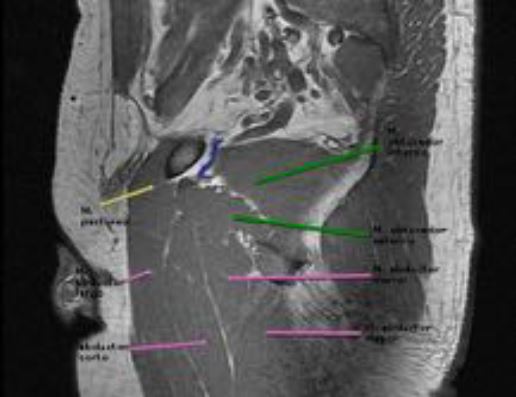Hernia obturatriz:
diagnóstico preoperatorio.
Palabras clave:
Hernia obturatriz, poster, seramResumen
Objetivos Docentes
La hernia obturatriz es un tipo extremadamente raro de hernia con relativamente alta mortalidad y morbilidad. Su diagnóstico precoz es difícil, puesto que los signos y síntomas no son específicos. El propósito de esta presentación es mostrar los hallazgos radiológicos que permiten establecer el diagnóstico preoperatorio de la hernia obturatriz, siempre y que previamente exista un alto índice de sospecha. Una vez diagnosticada, el tratamiento es sencillo y el pronóstico es generalmente bueno.
Revisión del tema
Anatomía
El foramen obturador es el agujero anatómico más grande del cuerpo humano. Está formado por las ramas hueso isquion y pubis. El foramen está cerrado parcialmente por una fuerte barrera musculoaponeurótica conformada por una membrana obturadora interna y otra externa, además de un músculo obturador interno y uno externo. El conducto obturador está situado en la parte craneal de esta membrana, con el hueso púbico arriba y la membrana por debajo (Fig. 1). Este túnel mide, aproximadamente, de 0,2 cm a 0,5 cm de ancho y de 2 cm a 3 cm de largo, siendo atravesado por el nervio la arteria y la vena obturatrices, y comunicando la región abdominopélvica con el compartimento medial del muslo (Fig. 2).
Descargas
Citas
Perry CP, Hantes JM. Diagnosis and Laparoscopic Repair of Type I Obturator Hernia in Women With Chronic Neuralgic Pain. JSLS. 2005; 9: 138-41.
Sanjay M. Khaladkar, Anubhav Kamal, Sahil Garg, and Vigyat Kamal, “Bilateral Obturator Hernia Diagnosed by Computed Tomography: A Case Report with Review of the Literature,” Radiology Research and Practice, vol. 2014, Article ID 625873, 4 pages, 2014. doi:10.1155/2014/625873.
Kulkarni SR, Punamiyan AR, Naniwadekar RG, Janugade HB, Chotai TD, Singh TV et al. Obturator hernia: A diagnostic challenge. Int J Surg Case Rep.2013; 4: 606-8.
Glicklich M, Eliasoph J. Incarcerated obturator hernia: case diagnosed at barium enema fluoroscopy. Radiology.1989;172: 51-2.
N. Hodgins, K. Cieplucha, P. Conneally, and E. Ghareeb, “Obturator hernia: a case report and review of the literature,” International Journal of Surgery Case Reports.2013;4:889-92.
Schmidt PH, Bull WJ, Jeffery KM, Martindale RG. Typical versus atypical presentation of obturator hernia. Am Surg.2001; 67:191-5.
Hsu CH, Wang CC, Jeng LB, et al: Obturator hernia: a report of eight cases. Am Surg.1993; 59:709-11
Yip AWC, AhChong AK, Lam KH: Obturator hernia: a continuing diagnostic challenge. Surgery.1993;113:266-69.
Lo CY, Lorentz TG, Lau PWK: Obturator hernia presenting as small bowel obstruction. Am J Surg.1994; 167:396-98.
Hannington-Kiff JG: Absent thigh adductor reflex in obturator hernia. Lancet 1980; 1:180.
Green BT. Strangulated obturator hernia: still deadly. South Med J.2001;94:81-3.
Yokoyama T, Munakata Y, Ogiwara M, Kamijima T, Kitamura H, Kawasaki S. Preoperative diagnosis of strangulated obturator hernia using ultrasonography. Am J Surg. 1997;174:76-8.
Mantoo S K, Mak K, Tan T J. Obturator hernia: diagnosis and treatment in the modern era. Singapore Med J.2009;50:866.
Carriquiry LA, Pineyro A: Preoperative diagnosis of notstrangulated obturator hernia: the contribution of herniography. Br J Surg.1988;75:785.


